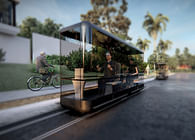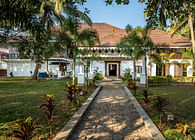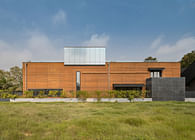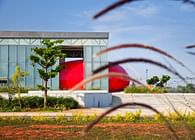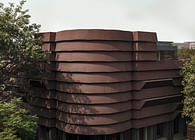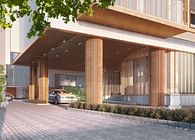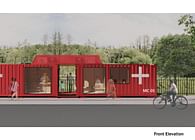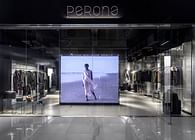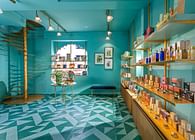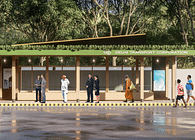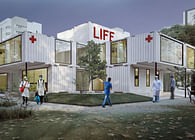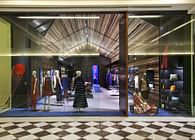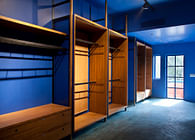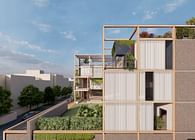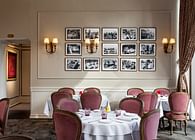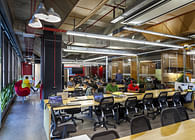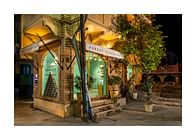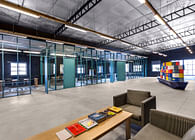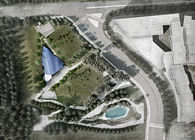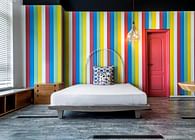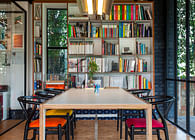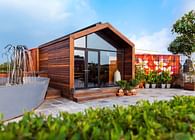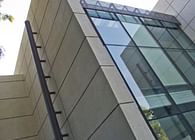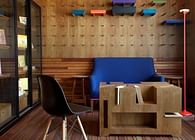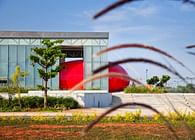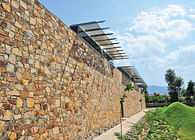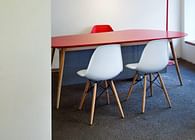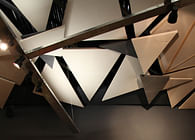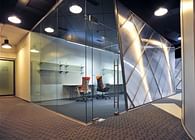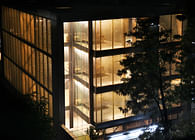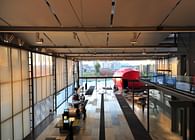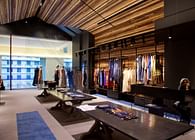
New Delhi, IN
Client Brief
The Oberoi Group of Hotels is India’s best hospitality brand and a leading one, globally. The Oberoi Office Tower is situated in the heart of the urban fabric of Gurgaon in Cyber City, which is the hub of commercial workspaces. Spread over 7 floors in the new tower, the Corporate Headquarters has been developed as a completely connected, corporate workplace.
Architecture Discipline was commissioned to create the 10,000 sq. ft. space for Arjun Oberoi, Managing Director and his Projects Development Team. The program also required an office for the Executive Chairman Prithvi Raj Singh ‘Biki’ Oberoi – a man hailed as one of India’s greatest hoteliers and the force behind the brand and the business.
The resultant design crafts space for two equally charismatic, but completely different individuals with diverse opinion, belonging to the same lineage, separated by almost forty years. The dynamic, avant-garde approach to the modern office, therefore respects the pedigree of the system, while pushing the work culture into a new age with a newfound expression.
Unique design features
The office intends to define the progressive attitude of the organization in order to nurture a healthy workspace community that provides possibilities for the brand vision to evolve over time. Gratifying the understated, yet exceedingly refined requirements of the brand that spearheads luxury hospitality in India, the office space befits the spirit of architecture and design standards in luxury hospitality. The key features include:
Glass box within a glass box to create an Oasis
The office has an external glass facade that allows a three-sixty-degree view of the charged urban context, while an internal glass courtyard provides relief and facilitates transparency across the floor plate. All good architecture is a quest for light and space. This project has been conceptualized as an oasis of nature that is calm and relaxing in juxtaposition to its immediate context by creating central glass courtyards that feeds the interiors with natural light.
High volumes of space, with layers crafted through glass
The workspace has a 16-foot-high ceiling, which informs the scale of the space and makes one feel energetic and positive. To enhance the transparency within the interior, low-reflective glass has been used to create layers. The result is a play with light and reflections that animate the space. The electronically operable blinds control daylight ingress and heat gain.
Nature and Repose
The courtyard provides a space for repose with cascading greens in two different characters. One with timber deck and a single olive tree while the other is a formal chequered arrangement with Wedelia and Thassos pebbles.
Design style or philosophy
A distinct open plan workspace lends its users the privacy needed for their work profile. The spaces are organized strategically to aid in productive life cycle of the workspace. Care has been taken to future proof the workspace functionally and technically. Individual workplaces with customized modular furniture are dotted through the space using the kit-of-parts strategy, such that they can be reconfigured to meet evolving needs over time. The office can transform and evolve, while still maintaining its design identity.
Energy and environment
Our buildings, neighborhoods and cities should be designed to minimize pollution and carbon emissions. This implies not only using renewable sources of energy but designing energy efficient buildings and designs that incorporate vegetation and biodiversity. The office has received a LEED platinum certification, with the use of high-performance glass along with heat reflective blinds that modulate and control the heat gain in the building. The optimized MEP services design for the building increase energy efficiency and minimize consumption of resources and emission of waste.
Flexibility
Today’s buildings are evolving landscapes; work, leisure and domestic activities are becoming interchangeable, leading to the creation of open-ended flexible buildings. Adaptable frameworks with well-serviced and well-lit spaces that can be used for multiple activities in the short term – offer the possibility of a long-life span for the building and a variety of possible long term uses.
Equality, Teamwork and User Behaviour
The office is an example of how design can be used to break down hierarchies and create positive environments. The level of richness that can be achieved by understanding what a building is and how it can develop a wider sense of community for its users is truly remarkable. The design embraces the ideas of teamwork and social responsibility and encourages collaboration on all projects, both within the office and with visiting designers, consultants and specialists. Architecture has the power of affecting and controlling its user’s behavior. The design also reflects on the behaviour of the users to observe decorum, poise and orderliness.
Seamless design and Technology
The design seamlessly merges the digital, analogue and natural realms within the space. The office is embedded with state-of-the-art technology, Bluetooth/ Wi-Fi networks, wall-mounted tablets and smartboards that facilitate productivity. The MEP, lighting design and IT integration are all concealed to ensure a seamless design.
Materiality
Pioneering the spirit of sophisticated corporate workspaces, unobtrusive backdrop tones of charcoal and gray are muted with beige surfaces and red splashes- making the composition of spaces simple, cosmopolitan and utilitarian. All services in the building are carefully orchestrated and selectively exposed. Wooden fiber panels painted in charcoal are used for a minimal ceiling to control acoustics while the rest of the post tensioned slab is left exposed lending an interesting rhythm to the ceiling pattern. The floor finish is primarily polished micro concrete with strategic zones with walnut floor boards that add warmth. The courtyard features a long solitary granite block bench floating within a timber deck floor. The machine-fabricated furniture, that is manufactured in frugal material acts as a fulcrum of distinct conducive sensibilities.
The glass courtyard
The design of both the spaces has repose and nature at the core. The courtyard for the Chairman’s office is a structured space with an olive tree sitting within a grid of Wedelia and white pebbles with green vines cascading from above. This lends a peaceful and meditative view to the corridor and all the spaces zoned around the courtyard.
The second courtyard has a singular olive tree placed on a timber deck and a sculptural bench. It’s a more energetic and dynamic space, the function of which is open to interpretation.
LEED Platinum certification
The office is LEED platinum certified. The selection of the glass and processing considers a 25-year life span. Environmental heat gain is reduced through the configuration of the glass panels and blinds. Small spaces tend to heat up faster and since the office is designed as one large space, heat gain and pockets are negligible. Wood fibre is used strategically to reduce acoustic noise. The optimized MEP services design for the building increases energy efficiency and minimizes consumption of resources and emission of waste.
Arjun Oberoi’s (Managing Director) Office and the Project Development Team:
The office includes a closed conference room, a meeting room, the Managing Director’s office, Senior Vice President cabins, a large collaborative workstation zone and a casual lounge space.
Arriving at the office reception, one is presented with the view of a large, unexpectedly green courtyard around which different zones are located. A lounge on the left with books and accolades in display is programmed as a break out zone to have casual meetings and discussions or occasionally watching an important cricket match. This flows into a large open space with workstations and collaborative desks and open SVP cabins designed as a series of specific elements, each of which occupy distinct zones of the plan. Turning to the corner around the courtyard leads one to the meeting and conference rooms. At the end of the corridor is the Managing Director’s office.
Augmenting the same sensibilities of the brand and its character, adding a little sky thinking to the owner’s automobile enthusiasm, a piece of aviation history has been installed in the Managing Director’s office. A decommissioned Cessna aircraft’s 8m long wing has been turned into an eye-catching table top. The aluminum structure of the table top is a light animated object and an impression of the owner’s sci-fi odyssey.
The Chairman’s Office:
The Executive Chairman’s office is stately and distinguished, stoic yet flamboyant. The design employs a clean arrangement and the use of geometry in terms of spatial organization and crisp leading lines that reflect the contemporary simplicity and refined dimensional character of the company. Aesthetically, the interior spaces are designed to flow seamlessly, creating a relaxed experience where light is the primary protagonist. Warm shafts of sun penetrate deep into the interior spaces giving it the feel of a spacious daylight-filled art gallery.
The reception of the pristine all white office for the chairman greets every visitor with a striking view of the bronze wall feature and a glimpse of the courtyard garden. The formal waiting area seating offers an expansive view of the city. A minimalist brass inlay pattern in a seamless white Thassos floor finish guides one along to the subsequent spaces - a large board room followed by a formal dining hall, chairman’s cabin and a secretariat pool. The boardroom features a teak floor finish, rich fabric paneling on walls, a floating tapered ceiling design and a long linear table with a fluted walnut base and a leather gilded table-top. The integrated smart automation, for video conferencing, lighting controls and operating roller blinds gives its users a premium experience.
Mr. Biki Oberoi’s cabin features a dignified dark stained walnut desk with a perforated bronze metal modesty panel, fine handcrafted leather gilded top, with the backdrop screen continuing the metal lattice language inside the room. The enclosing wall in the room is designed as a shelving cabinet that adds a sense of personalization. A lounge sofa seating with a bronze + tinted glass coffee table and Carrara marble top side tables make for a relaxing space for small intimate discussions. The chairman has direct access to the dining room from within his cabin, which features a bespoke table with a double layered smoked glass top resting on two delicate bronze lattice bases in funicular forms. This dining room is serviced by a restaurant equivalent kitchen that is tucked away and invisible to any of the guests. A sophisticated spatial experience has been curated using a very limited material palette. The white floors, ceilings and walls form the base canvas with warmth added using timber and textured fabric panels. Accents in bronze elevate this material mood and betoken luxury.
Status: Built
Firm Role: principle architect
